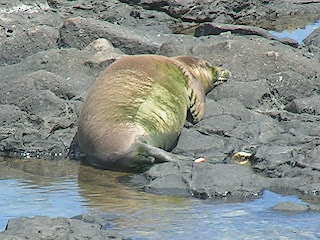The following comes from the Governor's weekly E-Newsletter:
The Department of Land and Natural Resources (DLNR) is implementing new measures to improve its management of the Kealakekua Bay State Historic Park on Hawaii Island and better protect its sensitive natural, historic and cultural resources through education.
Kealakekua Bay State Historical Park on the Big Island of Hawai`i is the site of the first extensive contact between Hawaiians and Westerners with the arrival of Captain Cook in 1779.
 To prevent damage to the shoreline and coral reef and accidental destruction of significant historic and cultural sites by large numbers of visitors, DLNR is now requiring that visitors to the park receive information regarding the sensitive sites and guidance on how they can help preserve the natural beauty of the area during their visit.
To prevent damage to the shoreline and coral reef and accidental destruction of significant historic and cultural sites by large numbers of visitors, DLNR is now requiring that visitors to the park receive information regarding the sensitive sites and guidance on how they can help preserve the natural beauty of the area during their visit.
Effective February 23, 2010, information will be provided through a simple permit system for people seeking to land vessels along the Ka‘awaloa shoreline or moor at the wharf adjacent to the Captain Cook Monument in the bay.
"Residents can easily access free education and cultural practices permits that will provide guidance to ensure there is no accidental damage to the cultural sites," said Laura H. Thielen, DLNR chairperson.
"Visitors have guided tours to ensure they appreciate the historical and cultural significance of the areas and eliminate inadvertent damage," she added. "In the meantime, the entire bay remains open to all people to enjoy the pristine waters and marine life."
Signs will be posted at entry locations along the bay to notify people of this new system and provide information on how to obtain a permit.
Kealakekua Bay State Historical Park and Ka`awaloa peninsula within the bay are two of Hawai`i's most significant historical and cultural locations, with an abundance of fragile and significant archaeological sites. Ka`awaloa is the shoreline commonly used to access the famous Captain Cook Monument from the bay. Boaters also use this shoreline to beach their vessel before snorkeling at Ka`awaloa Cove.
DLNR has conducted recent law enforcement actions at the pier in cooperation with Hawai`i County Police to address illegal commercial rental of kayaks. Several illegal kayaks have been confiscated. The department is informing kayak rental vendors of the new permit requirement, and requesting that the vendors advise their customers of the landing without a permit restriction.
DLNR Enforcement officers have posted and distributed the same notice at Napo`opo`o Pier. DLNR will also implement an outreach plan to kayak and ocean recreation companies, visitor and resident recreational interests.
Visit the DLNR website to learn more.














